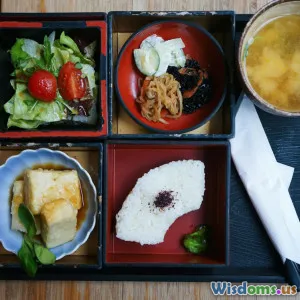
A Day Eating Like a Traditional Ethiopian Family
8 min read Experience the rich flavors and cultural traditions of an Ethiopian family’s daily meals in this immersive article. (0 Reviews)
A Day Eating Like a Traditional Ethiopian Family
Ethiopian cuisine is a colorful tapestry woven with history, culture, and communal warmth. To eat like a traditional Ethiopian family is not just about savoring bold, unique flavors—it’s about embracing a deeply rooted cultural experience where food becomes a medium of connection, storytelling, and hospitality. In this article, we will journey through a typical day eating with a traditional Ethiopian family, exploring morning rituals, mid-day feasts, and the iconic coffee ceremonies that conclude their day.
Morning: Starting the Day With Simple Nourishment and Community
The Traditional Ethiopian Breakfast
In many Ethiopian households, breakfast is a modest yet filling affair. Unlike the sugary cereals or heavy pastries common in Western traditions, Ethiopian breakfasts focus on nourishing staples that energize for the day ahead. Typical choices include:
- Genfo: A thick porridge made from barley or wheat flour, served with spiced clarified butter (niter kibbeh) and a dipping of berbere (a chili-based spice mix).
- Kinche: Cracked roasted wheat cooked until soft, resembling a coarse porridge.
- Chechebsa: Pieces of fried flatbread mixed with berbere and melted clarified butter, offering a spicy start to the day.
These dishes emphasize warmth and heartiness, ideal for the Ethiopian highland climate where mornings can be crisp. Sharing a breakfast table, family members often engage in lively conversation, preparing everyone mentally and physically for the day’s activities.
Example insight: According to Ethiopian nutrition research, whole grains used in these dishes provide sustained energy and essential fiber, supporting digestive health and cognitive function—a natural way families fuel themselves without processed sugars.
Midday: Communal Lunch as the Heart of Ethiopian Eating
Injera: More Than Just a Bread
At the center of every Ethiopian meal lies injera, a large sourdough flatbread made from teff flour, which is not only gluten-free but packed with iron, calcium, and protein. Injera serves a dual purpose: it is both the plate and the utensil. The texture and slightly tart taste of injera perfectly complement the variety of stews and vegetables it accompanies.
The process of making injera is a revered tradition: teff flour is mixed with water to ferment for several days before cooking on a large clay griddle called a mitad. The result is a spongy, porous bread that soaks up flavors expertly.
The Arrays of Wat and Tibs
Traditional Ethiopian lunch involves a communal platter adorned with several kinds of wat (stews) and tibs (sautéed meats and vegetables):
- Doro Wat: A spicy chicken stew simmered in berbere and clarified butter, considered Ethiopia’s national dish.
- Misir Wat: Lentil stew often spiced with garlic, onions, and berbere.
- Shiro Wat: Ground chickpea or broad bean stew, a vegetarian staple rich in protein.
- Tibs: Sauteed meat or vegetables, typically lamb or beef tossed with rosemary and spices.
Eating is a communal affair; everyone gathers around a large injera platter, tearing pieces to scoop stews. This practice symbolizes unity and respect.
A Family Ritual: The Etiquette and Significance
Eating Ethiopian-style requires certain etiquettes that emphasize respect and bonding. For example, feeding one another a piece of injera with stew is a loving gesture especially between parents and children or among spouses—known as "gursha".
Real-world insight: Anthropologists note that communal eating in Ethiopian society fosters social cohesion and reinforces family hierarchies while allowing expression of affection.
Afternoon: Refreshing Breaks and Traditional Snacks
Ethiopian families often enjoy tea or light snacks in the afternoon. Traditional snacks include kolo (roasted barley or chickpeas) and fresh injera rolls filled with spiced butter and honey. These not only provide energy but maintain social bonds through shared moments.
Evening: The Iconic Ethiopian Coffee Ceremony
Origins and Cultural Significance
No Ethiopian day concludes without the renowned coffee ceremony—a ritual that transcends drinking coffee. Ethiopia is the birthplace of coffee, and this ceremony embodies hospitality, respect, and community.
The Ceremony Steps
- Roasting: Green coffee beans are freshly roasted over a small fire or brazier.
- Grinding: Roasted beans are ground with a mortar and pestle.
- Brewing: Coffee is brewed in a jebena, a traditional clay pot.
- Serving: Coffee is served in small cups, often with popcorn or roasted barley.
Families gather as the host serves three rounds of coffee, called abol, tona, and bereka—each representing increasing strength and blessing. This ceremony is lengthy and deliberate, demonstrating care and a chance for meaningful conversation.
Example quote: A traditional Ethiopian saying states, "Coffee is the key to the home," highlighting the coffee ceremony's central role in family life.
Nutritional and Cultural Takeaways
Ethiopian cuisine marries nutrition with culture seamlessly. The reliance on whole grains like teff offers superior iron and protein to many global staples. The prevalence of legumes and vegetables in wats supports balanced diets, even in vegetarian households. Traditional cooking methods and communal dining foster physical well-being and interpersonal connections.
Ethiopian families’ approach to food exemplifies how meals can nourish the body, spirit, and social relationships, a lesson relevant in today’s fast-paced world.
Conclusion: More than Food—A Cultural Experience
Spending a day eating like a traditional Ethiopian family reveals layers of history, love, and community held together by food. It’s an experience of joyful sharing, rich flavors, and respectful tradition. For those looking to enrich their culinary horizons or deepen understanding of diverse cultures, embracing Ethiopian mealtime rituals offers a delicious and enlightening path.
Whether through the tang of injera under vibrant stews or the soulful rhythm of the coffee ceremony, Ethiopian cuisine teaches us that food is never just about sustenance—it’s about belonging, celebration, and life’s simple yet profound pleasures.
Rate the Post
User Reviews
Other posts in Global Cuisines & Nutrition
Popular Posts
















